On Earth Day 2024, Principal Deputy Assistant Secretary Jeff Marootian shares a few thoughts on circularity.
Office of Energy Efficiency & Renewable Energy
April 22, 2024On Earth Day 2024, Principal Deputy Assistant Secretary Jeff Marootian shares a few thoughts on circularity.
You can trace the life cycle of most manufactured products with a straight line. We harvest the raw material, shape it into something useful, use it until it breaks, then throw it away. This Earth Day, I've been reflecting with pride on my office's efforts to make our model of production a bit less wasteful. Through funding allocations, technical assistance, and targeted research and development (R&D) investments, the U.S. Department of Energy (DOE) is using its considerable resources to bend that straight line into a circle.
As we work toward our midcentury goal of net-zero emissions, we're constantly seeking new ways to optimize the use and reuse of important technologies and materials. Efficient recycling will not only strengthen our clean energy supply chains, but also accelerate our progress toward net zero by curbing emissions from manufacturing and waste management. That carbon-cutting feedback loop is a major benefit of what we call the "circular economy."
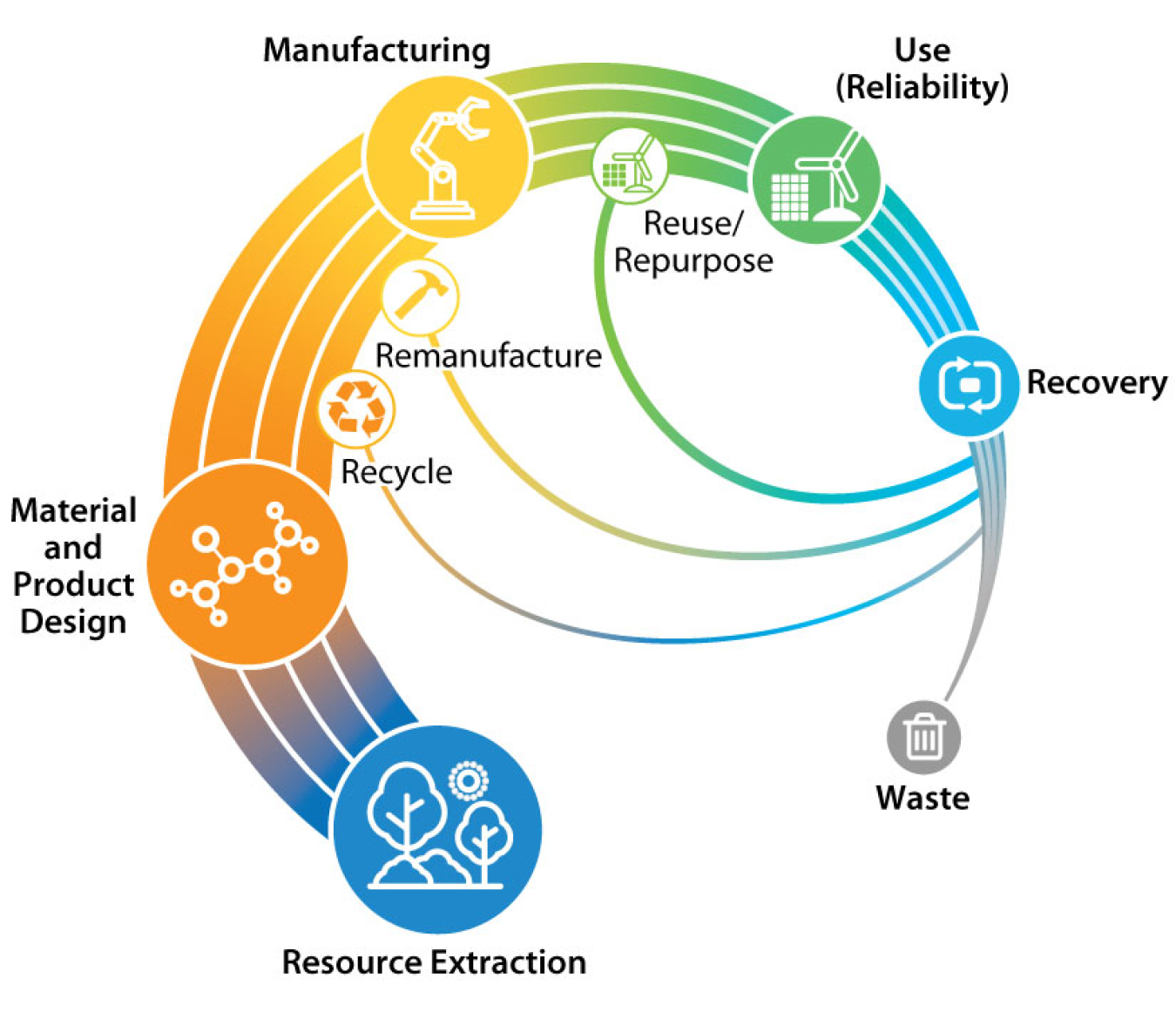
Effective recycling can reduce waste and costs by repurposing, recycling and remanufacturing materials that would otherwise end up in landfills.
Let me give you an example. Products that are powered by electricity—the smartphone in your pocket, the microwave in your kitchen, the computer on your desktop—are the fastest-growing source of waste on Earth. In 2019, we managed to recover and recycle less than one fifth of this waste, leaving an estimated $57 billion in material value (think of the cobalt or lithium in your phone's battery) on the garbage heap. This problem is only becoming more severe; waste from electronic products is projected to grow by 100%, relative to 2014 levels, by 2030.
So, last month, DOE launched the Electronics Scrap Recycling Advancement Prize (E-SCRAP), which will award up to $4 million to competitors who develop methods for substantially increasing the production of critical materials recovered from electronic scrap—or "e-scrap." As my office's long history of support for early-stage R&D demonstrates, these targeted investments can yield massive returns. We're hopeful that the E-SCRAP prize will produce multiple breakthrough solutions to one of our most pressing recycling challenges.
Also last month, DOE announced $62 million in funding from the Bipartisan Infrastructure Law (BIL) for projects that will reduce the cost of recycling batteries from consumer electronics. This timely investment will help our rate of recycling keep pace with the surge in electric vehicle (EV) sales under the Biden-Harris administration, which reached a record high of more than 1.4 million last year. Given that the lithium-battery market could increase tenfold by 2030, improving the economics of battery recycling is a necessary measure to ensure sustained growth.
Several of our technology programs have launched promising initiatives of their own. In January, the Wind Energy Technologies Office announced the winners of the first phase of the Wind Turbine Materials Recycling Prize—another BIL-funded initiative that will award up to $5.1 million to participants that develop sustainable, cost-effective recycling processes for wind turbine materials. In the Solar Energy Technologies Office, our team continues to investigate methods for improving the durability and recyclability of solar modules. Meanwhile, the Vehicle Technologies Office has been managing a large portfolio of EV-battery recycling projects, which have received nearly $74 million in BIL funding to date.
In many cases, we don't need to dig through the trash to recover wasted value. In the long run, practices that extend the lifetime of a product can conserve more energy and avert more emissions than recycling alone. The Re-X Before Recycling Prize, launched in November of 2023, is awarding cash prizes and in-kind technical assistance to projects that wring additional value out of products through reuse, repairs, refurbishing, remanufacturing, or repurposing before recycling. These life-extending measures reduce the embodied energy and carbon of manufactured goods, strengthen domestic supply chains, and create jobs—all while avoiding the environmental harm that comes with every new addition to a landfill.
Earth Day is an annual reminder of our responsibility to be good stewards of our planet—and that responsibility extends to the methods we use to build a cleaner, healthier world. As DOE spearheads the transformation of our energy system, we'll continue to find new ways to reduce waste and modernize our recycling practices. Today, I'm grateful to my colleagues who have been tirelessly hammering that straight line into a circle.
Jeff Marootian
Former Principal Deputy Assistant Secretary
Jeff Marootian was the Principal Deputy Assistant Secretary in the Office of Energy Efficiency and Renewable Energy. He previously served as a Senior Advisor to Energy Secretary Jennifer Granholm and as Special Assistant to the President in the Biden-Harris White House. He was also a member of the Biden-Harris Presidential Transition Team.
Prior to joining the Biden-Harris Administration, Jeff was the Director of the District Department of Transportation, where he led the adoption of sustainable transportation technologies and oversaw more than $4 billion of critical infrastructure and utility projects including the reconstruction of the historic Frederick Douglass Memorial Bridge.
Mr. Marootian previously served in the Obama-Biden Administration as the Assistant Secretary for Administration and Chief Sustainability Officer at the U.S. Department of Transportation. He is an alumnus of The George Washington University where he has also taught as an adjunct faculty member in the Trachtenberg School of Public Policy and Administration.
Clean Energy In Action
-
 Sacramento Municipal Utility District has several workforce developments programs that help local residents like Uriah Harris, Samson Nguyen, and Miguel Vela enter union apprenticeships, building the skills they need to land in-demand trade jobs.
Sacramento Municipal Utility District has several workforce developments programs that help local residents like Uriah Harris, Samson Nguyen, and Miguel Vela enter union apprenticeships, building the skills they need to land in-demand trade jobs. -
 DOE and its partners celebrate the installation of a new hydrogen fueling station at Lincoln Financial Field.
DOE and its partners celebrate the installation of a new hydrogen fueling station at Lincoln Financial Field. -
 Happy Geothermal Day! Today, we are celebrating you and only you, one of our favorite sources of renewable energy.
Happy Geothermal Day! Today, we are celebrating you and only you, one of our favorite sources of renewable energy. -
 Sunvapor designed a solar collector to cut costs and optimize the supply chain by using less energy to manufacture the structural components.
Sunvapor designed a solar collector to cut costs and optimize the supply chain by using less energy to manufacture the structural components. -
 Securing America’s critical material supply chains has become even more vital to the clean energy economy, and the CMI Hub is mission-focused on addressing the critical materials challenges of today and tomorrow.
Securing America’s critical material supply chains has become even more vital to the clean energy economy, and the CMI Hub is mission-focused on addressing the critical materials challenges of today and tomorrow. -
 Angela Wilkins is a union worker helping to manufacture wind turbine generators at the Ingeteam plant in Milwaukee. The growth of U.S. clean energy manufacturing has afforded her a secure job with good pay, great benefits, and nice people to work with.
Angela Wilkins is a union worker helping to manufacture wind turbine generators at the Ingeteam plant in Milwaukee. The growth of U.S. clean energy manufacturing has afforded her a secure job with good pay, great benefits, and nice people to work with. -
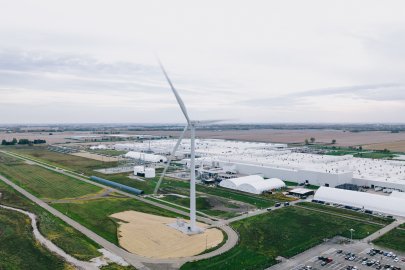 Learn about key facts related to wind turbines used in distributed applications.
Learn about key facts related to wind turbines used in distributed applications. -
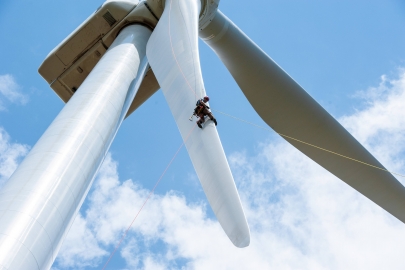 Brush up on your knowledge of wind! Get the details on a few of the lesser-known wind energy facts.
Brush up on your knowledge of wind! Get the details on a few of the lesser-known wind energy facts. -
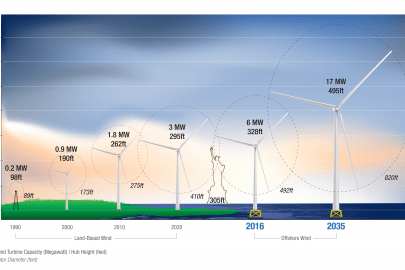 Since the early 2000s, wind turbines have grown in size—in both height and blade lengths—and generate more energy. What’s driving this growth? Let’s take a closer look.
Since the early 2000s, wind turbines have grown in size—in both height and blade lengths—and generate more energy. What’s driving this growth? Let’s take a closer look. -
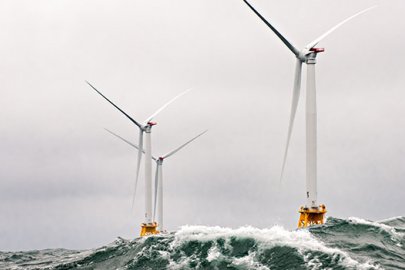 Learn more about efforts to develop America's vast offshore wind resources.
Learn more about efforts to develop America's vast offshore wind resources.
Sign-up to receive the latest information about EERE’s clean energy prize and competition opportunities.
Get the latest clean energy updates in your inbox every Wednesday.

